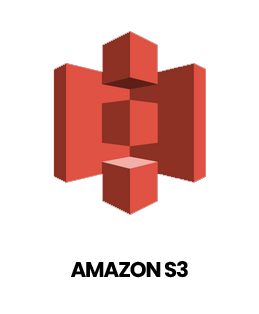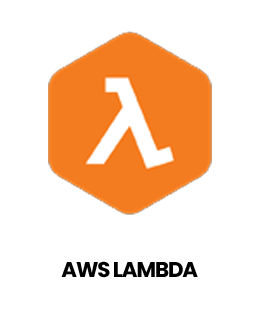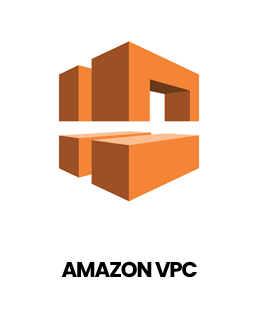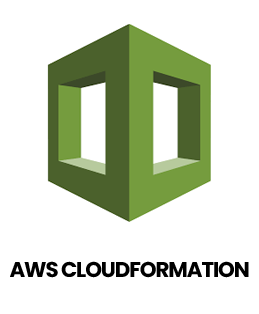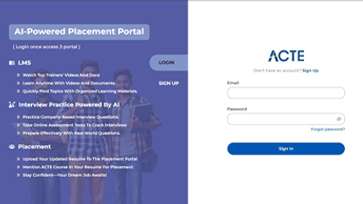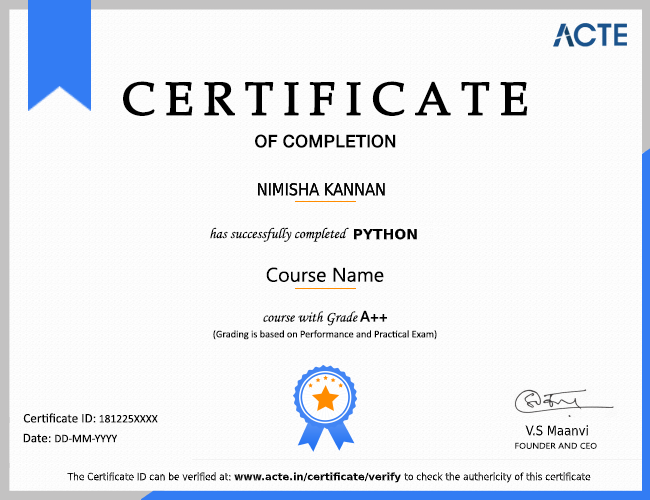About AWS Certification Online Training Course
The primary goal of ACTE Training is to provide live classes from live instructors whose approach to teaching uses a balance of lecture and hands-on exercises. This gives students the ability to learn quickly during our classes. To support this goal, we’ve developed multiple ways to attend our classes, wherever you may be located. We’ll ship you any course material about 1 week prior to your class start date. We provide access to any needed software and lab environments during your class.
Benefits
Amazon is an open-source community that is striving to make technology accessible to everyone. The various tools of AWS help deploy, track, scale, and manage various applications. These tools also help build modern applications and provide better quality and security.The growing demand for AWS that has given rise to several high paying job roles like AWS Certified Solutions Architect-Associate, AWS Certified Solutions Architect-Professional, AWS Certified Developer-Associate and more.
Amazon Web Services, popularly known as AWS Certification in the market, is a secure cloud service platform. It offers various functions for a business to scale up and grow such as computing power, content delivery, database storage and many other functionalities.
AWS Certification is a good career move for those who want to explore and grow in the field of cloud computing. With the help of AWS Certification , an individual, company, enterprises can get a cloud computing platform. For starting a career in AWS Certification as a fresher, first of all, you need to undergo training for AWS Certification .
Yes, you can get a job even when you are an AWS Certification fresher. But make sure you know all about AWS Certification Cloud. However, only learning about the AWS Certification cloud is not enough to get your hands on a good job.
We are happy and proud to say that we have strong relationship with over 700+ small, mid-sized and MNCs. Many of these companies have openings for AWS Certification . Moreover, we have a very active placement cell that provides 100% placement assistance to our students. The cell also contributes by training students in mock interviews and discussions even after the course completion.
AWS Certification is primarily an Infrastructure as a Service (IaaS) Cloud Platform. You need not know any programming to be successful in AWS Certification “mostly”. However, all of that depends on exact role you get into. If you are writing scripts/programs for automation/control of AWS Certification services, programming knowledge is a must.
- Having basic knowledge of operating systems like Windows OS, Linux etc
- As Visualization play a major role in AWS Certification you need to have the understanding of it
- Networking is an essential skill as all operations on cloud platform involves it.
- Understanding the difference between the Public and Private cloud
- Last but not the least, you must have basic command over coding
- AWS Certification , Python or C# Most architects have a software development background.
- Networking.
- Data storage fundamentals.
- Security foundations.
- AWS Certification service selection.
- Cloud-specific patterns and technologies.
- Communication.
Our courseware is designed to give a hands-on approach to the students in AWS Certification . The course is made up of theoretical classes that teach the basics of each module followed by high-intensity practical sessions reflecting the current challenges and needs of the industry that will demand the students time and commitment.
The future of AWS Certification is bright. Infact, it's the future of modern day computing. Cloud computing, machine learning, IOT, etc are some of the domains which have a lot to offer in the near future.
Depending on how much experience you already have, it’s possible to learn AWS Certification in 3 days with our instructor-led courses comprising of 18 hours of training. If you’re looking to gain AWS Certification certification this will take a little longer, as you’ll also need to prepare for the exam.
- Customization.
- Flexibility & Scalability.
- PaaS Offerings.
- Security.
- Scheduling.
- Recovery.
- Consistency.
- Global Architecture.
AWS CloudFormation
A key tool in our cloud configuration management toolset, AWS CloudFormation is a powerful Infrastructure as Code tool that helps automate and manage all your AWS deployments painlessly. AWS CloudFormation provides a common language for you to model and provision all the infrastructure resources in your cloud environment. As a configuration orchestration tool, it allows you to codify your infrastructure to automate your deployments. Here are some CloudFormation‘s primary features:
- Templates:CloudFormation templates can be created with YAML in addition to JSON. Alternatively, you can use AWS CloudFormation Designer to visually create your templates and quickly see the interrelationship between a template’s resources.
- Dependency management:during the configuration process, AWS CloudFormation automatically manages dependencies between your resources. Therefore, you don’t have to specify the order in which resources are created, updated, or deleted. CloudFormation determines the correct sequence of actions to create your environment.
- Preview changes to your environment:if you’re not sure what changes might break the environment, AWS CloudFormation Change Sets allows you to preview how proposed changes to a stack might impact your running resources. AWS CloudFormation makes the changes to your stack only after you decide to execute the Change Set.
- Safety controls:even if you execute a change set which contains errors, CloudFormation has Rollback Triggers that allow you to monitor your update process and roll back your environment to a previous deployed state. You can use Rollback Triggers to specify the CloudWatch alarm that CloudFormation should monitor during the stack creation and update process. If any of the alarms are breached, CloudFormation rolls back the entire stack operation to a previous deployed state.
- Cross account & cross-region management:AWS StackSets enables you to create, update, or delete stacks across multiple accounts and regions with a single operation. Before StackSets existed, every infrastructure environment had to be deployed independently. AWS StackSets makes it easier to maintain consistency when you add new regions and accounts.
- Finally, AWS frequently releases additional useful functionality, so there are unlimited possibilities on what you can do with CloudFormation.
Benefits
Model it all
- Model your entire infrastructure and application resources with either a text file or programming languages.
- The AWS CloudFormation Registry and CLI make it easy to manage third party resources with CloudFormation. This provides a single source of truth for all your resources and helps you to standardise infrastructure components used across your organisation, enabling configuration compliance and faster troubleshooting.
Automate and deploy
- AWS CloudFormation provisions your application resources in a safe, repeatable manner, allowing you to build and rebuild your infrastructure and applications, without having to perform manual actions or write custom scripts.
- CloudFormation takes care of determining the right operations to perform when managing your stack, orchestrating them in the most efficient way, and rolls back changes automatically if errors are detected.
It's just code
- Codifying your infrastructure allows you to treat your infrastructure as just code. You can author it with any code editor, check it into a version control system, and review the files with team members before deploying into production.
Ready for Integration
- You could amalgamate AWS CloudFormation and the management and development tools you like. CloudFormation publishes events of advancements via Amazon SNS (Simple Notification Service). Using SNS, you may keep track of stack builds and deletion improvements through emailand programmatically merge them with other processes.
Drag-and-Drop UI to Visualise and Edit
- AWS CloudFormation Designer offers a template diagram with icons denoting the Amazon platform's resources and arrow signs indicating relationships. You could create and modify templates using the interfaceand then alter template details with the help of the inbuilt JSON text editor.
- Also, CloudFormation Designer lets you spend extra time on infrastructure design and little time on manual coding of templates.
Customisation through Parameters
- You may use parameters for customising specific template aspects at run time. For instance, you could pass the Amazon EC2instance types, Amazon EBS volume size, RDS database size, server port numbers, and database to the platform when creating a stack.
- Also, you could utilise a parameterised template for creating multiple stacks that could vary in a steered manner. For instance, your alarm thresholds for Amazon CloudWatch, Amazon EC2 and Amazon EBS instance variants, and read-replica settings relating to Amazon RDS could vary if you get additional user traffic in America compared to Europe.
- You could use template criterion to individually tune thresholds and settings in different regions and still make sure the application is consistently deployed across regions.
Support for Different Resources
- AWS CF assists a smorgasbord of resources, which lets you make a highly reliable, available, and scalable or upgradeable AWS infrastructureto cater to your specific application requirements.
- With CloudFormation, it’s easy to classify and station a suite of the secure platform's resources. It allows you to describe any contingencies or special yardsticks to pass in during runtime. You may employ any of the several CloudFormation sample templates verbatim or as a beginning point.
Show More



